The Top 5 IT Services Providers 2017 | Market Insights™
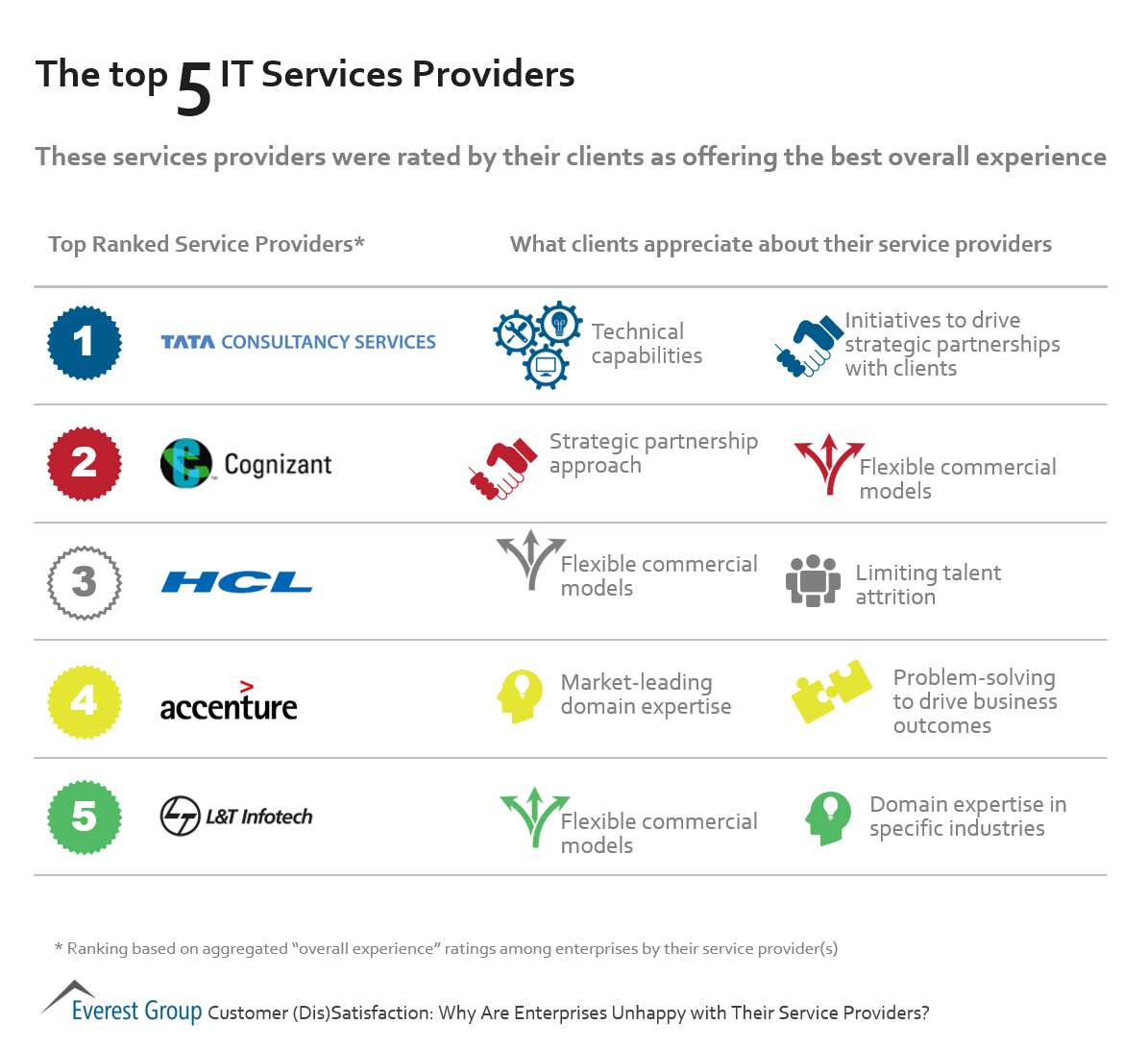
These services providers were rated by their clients as offering the best overall experience

These services providers were rated by their clients as offering the best overall experience
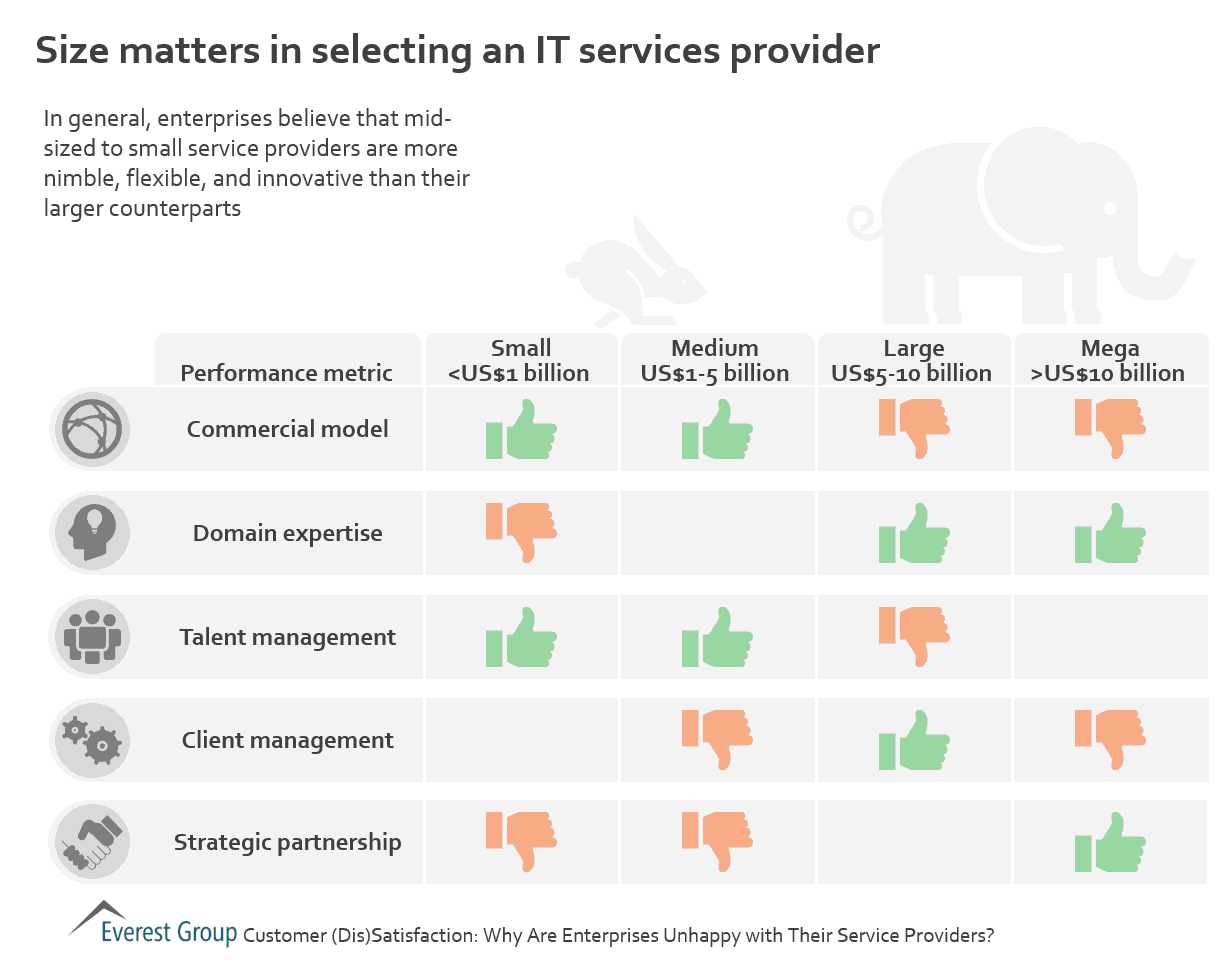
In general, enterprises believe that mid-sized to small service providers are more nimble, flexible, and innovative than their larger counterparts
Accenture, Cognizant, IBM, TCS and Wipro again top the list of IT service providers who consistently place among top performers in Everest Group’s PEAK Matrix™ reports.
Everest Group—a consulting and research firm focused on strategic IT, business services and sourcing—today announced the winners of the 2017 PEAK Matrix Service Provider of the Year™ awards for IT services. The awards, now in their second year, recognize IT service providers who have demonstrated consistent leadership in the PEAK Matrix reports issued by Everest Group in the previous year.
In 2016, Everest Group published 21 PEAK Matrix reports, evaluating a total of 73 service providers in various segments of the IT services market. Twenty of the 73 providers are recognized in the 2017 PEAK Matrix Service Provider of the Year Awards.
“Our PEAK Matrix reports evaluate market success—using factors like revenue growth, deals won or renewed, margins generated, and so forth—as well as service capabilities, where the emphasis is on innovation, because that is how providers are differentiating themselves in the eyes of enterprises today,” said Jimit Arora, partner at Everest Group. “Throughout the year, Everest Group examines what providers are investing in, what type of intellectual capital they have, how they’re devising their sourcing strategies, and whether they are experimenting with new service models or engagements with their customers. By taking all of that into account, these PEAK Matrix Service Provider of the Year awards recognize the IT providers that truly set themselves apart.”
The 2017 PEAK Matrix Service Provider of the Year Awards for IT Services comprise:
Accenture, Cognizant, IBM, TCS and Wipro won the top five spots (in that order). Accenture (which held the second position in 2016) has moved to the top of the list above Cognizant.
Companies recognized either as Leaders of the Year, Star Performers of the Year, or both, include Accenture, Atos, Capgemini, Cognizant, HCL, Hewlett Packard Enterprise, IBM, Tata Consultancy Services, VirtusaPolaris, and Wipro.
Accenture had a dominant presence in the 2017 honors, claiming the No.1 spot in the ITS Top 20 list as well as being “Leader of the Year” in the Overall IT Services and ADS categories. Accenture shared “Leader of the Year” honors with Cognizant in the HLS category.
Cognizant once again made a particularly strong showing, earning the No. 2 spot in the ITS Top 20 list as well as sharing “Leader of the Year” honors in two categories: BFSI and HLS. In addition, Cognizant was named “Star Performer of the Year” in the ADS category.
Capgemini and VirtusaPolaris shared the Star Performer of the Year award in the Overall IT Services category.
Five service providers improved their rankings:
New entrants to the ITS Top 20 list include Syntel (#17), Hexaware (#18) and NTT DATA (#20). Conversely, Fujitsu, Luxoft and Unisys dropped out of the Top 20 leaderboard.
***All winners are listed in the report, “2017 PEAK Matrix Service Provider of the Year Awards” available for complimentary download here.***
“Today’s enterprises must navigate a complex landscape of next-generation and legacy technologies, a global business footprint, and a complex provider portfolio,” said Abhishek Singh, practice director at Everest Group. “The PEAK Matrix Service Provider of the Year Awards are designed to help enterprise buyers identify the best of the best – the IT service providers with strong, broad-based capabilities and successful service strategies that align well with the evolving enterprise IT demand.”
Everest Group is proud to release the second edition of its annual PEAK Matrix Service Provider of the Year™ awards for IT Services 2017.
2016 was an interesting year for the IT services industry. Political upheavals (think Brexit and the U.S. presidential election), growing consumerization, the Internet of Things (IoT), and artificial intelligence were the key topics that defined the discourse of this highly watchful industry.
Everest Group took all of the above, and more, into account with its 2016 research. Under the aegis of four key IT Services (ITS) practices – Banking, Financial Services & Insurance (BFSI), Healthcare & Life Sciences (HLS), Application & Digital Services (ADS), and Cloud & Infrastructure Services (CIS) – we published a whopping 21 PEAK Matrix evaluations, assessing service providers on their capabilities and market success across multiple practice sub-segments.
Despite intense competition, politico-legal challenges, and the changing shape of technology adoption, the ITS market continues to grow, albeit at a slower pace. There are some service providers that, through their consistency and innovation, continued to lead the discourse on change and adaption. Hence, while there indeed are Leaders and Star Performers for each of the segments we evaluated, the composite picture clearly shows that some deliver consistent leadership and top performance across many different categories.
As today’s enterprises navigate the complex landscape of next-generation and legacy technology, a global business footprint, and a complex vendor portfolio, Everest Group’s PEAK Matrix Service Provider of the Year awards will help them to identify the best of the best – service providers with strong broad-based capabilities and successful service strategies that align well with the evolving enterprise IT demand.
The 2017 award categories are:
Here’s a PEAK peek at the top five on the ITS Top 20 leader board.
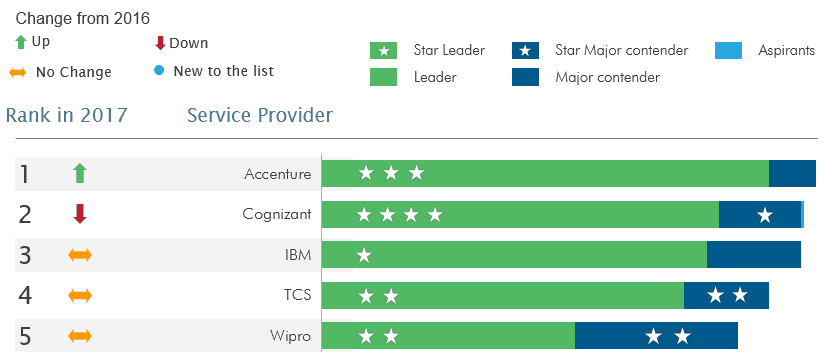
For the complete list of awardees, please click here.
Have you had experience with one or more of these providers? Our readers would love to hear your views about them!
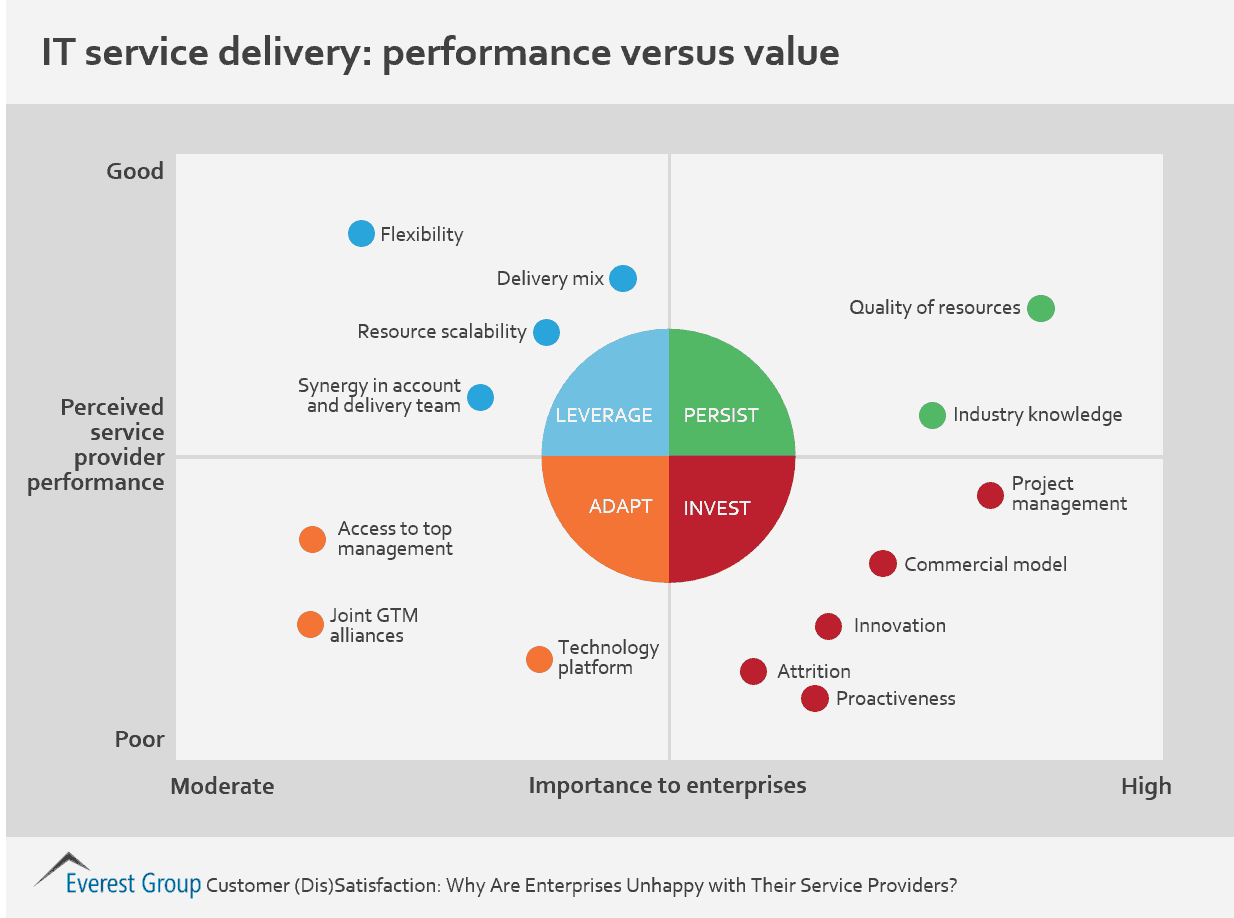
Compares IT service provider performance on specific services with the perceived importance to enterprises.
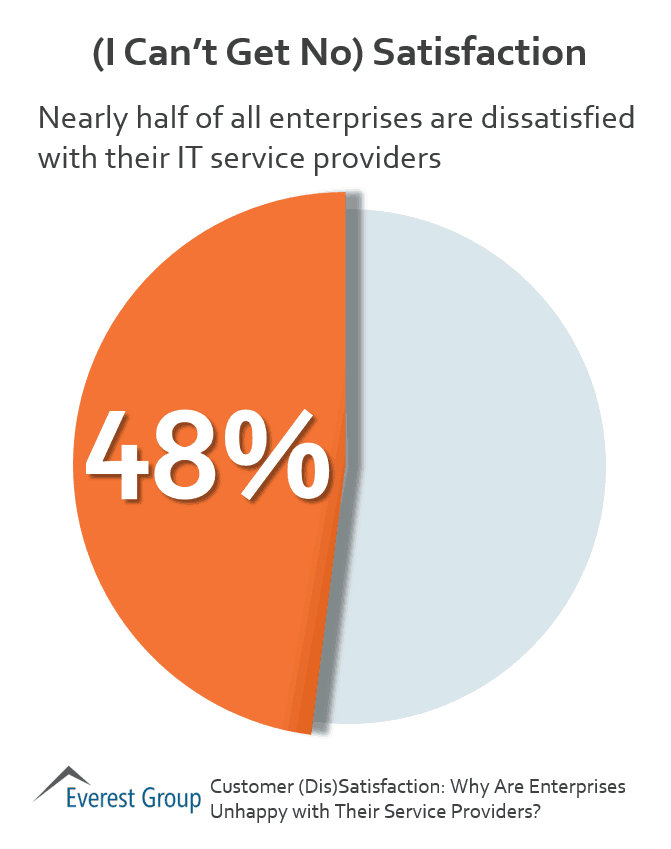
Nearly half of all enterprises are dissatisfied with their IT service providers
Just a month into 2017, the acceptability sentiment toward sending work offshore has changed. Companies are increasingly eager to explore ways to do work onshore which they would otherwise do offshore or is currently offshore. The question is how to do that without creating a negative cost impact.
A wide variety of factors are shifting the sentiment toward offshoring work, including …
Although US immigration reform is front and center in the media since the Trump administration took office, the US Congress has debated the need to change immigration legislation for years and has introduced significant proposals since 2013. An integral component is the H-1B work visas heavily used in the global services industry. Right now, the details of visa reform are a moving target, but there is a new angle in the shake-up – the proposed benefits are likely to benefit Global In-house Centers (GICs.
CNBC interviewed Congressman Darrell Issa (R-Calif.) this week about proposed policy changes and his discussions with President Trump. Issa stated that Trump believes foreign service providers are gaming the H-1B visa program, undermining the intent of the program.
He explained that Trump may be more favorable toward a policy capping the minimum H-1B salary at $135,000, as opposed to the current minimum salary of $60,000. Two other minimum salary proposals are on the table: $100,000 proposed by Issa and $132,000 proposed by Rep. Lofgren (D-Calif.). In essence, all three plans thus emphasize focus on allowing visas for high-skilled labor, and Issa affirmed that he expects Congress will pass bipartisan immigration reform dealing with high skills this year.
Two Greatest Impacts from Proposed Changes
It’s still unclear, but it’s likely that the changes won’t affect US providers and tech companies to the same degree as the third-party service providers in India. Changes aim to raise their onshore costs. This will significantly raise costs for H-1B-dependent providers such as Cognizant, Infosys and TCS. Although these firms currently enjoy a competitive advantage over Accenture, Capgemini and IBM, the advantage will narrow and potentially go away with the increased costs.
The second greatest impact from proposed changes is the GICs. Notably, the proposed legislation does not impact firms with GICs. In fact, it is likely to make the Indian GIC model (or captives) more attractive, thereby increasing employment opportunities in these Indian firms and giving these providers a greater share of the offshore pie. Why? Because reducing or restricting the available pool of H-1B talent when there is rising demand for US-based tech talent is likely to create wage inflation.
Although rising tech wages in the US will create a tailwind for all offshore models, GICs may benefit disproportionally because, unlike third-party providers, GICs don’t depend on the H-1B onshore model.
Digital Revolution Impact on Job Creation
Visa reform is not the only factor disrupting the labor arbitrage model. The emerging digital revolution holds the promise of significant productivity increases in the existing workforce – often as much as 30-60 percent. Coupled with US companies’ increasing risk of reputation damage for using offshore services, I believe the move to digital services will accelerate, as its value proposition includes the advantage of onshore delivery and relies less on service delivery based on the offshore labor arbitrage model.
H-1B-dependent service providers will likely use digital technologies and business models to offset the impact of rising wages. A short-term rise in employment is probable, given that it takes some time to implement digital productivity improvements.
No matter which side you’re on, the offshore labor arbitrage market is shifting. The US government definitely is moving aggressively in the direction of significant visa reform, especially focusing on high-skilled workers. However, the other items high on the loaded US policy agenda – especially repealing the Affordable Care Act and changing tax laws) could become a factor moving visa reform to a lower priority.
On a worldwide basis, companies are pausing efforts or taking a step back from globalization. In Europe, this is most evident in recent months with Brexit in the UK. In the United States, it is most evident in the proposals underway in Congress and the White House for H-1B visa reform, rising trade barriers, and potential changes to taxes that could change tax implications of offshoring. Although the extent of changes is not currently known, it is reasonable and probable that they will make offshoring more difficult and more expensive (for customers and their service providers) as well as less socially acceptable. Is your organization one of the many that are now seeking alternatives to sending work offshore to achieve cost reduction?
The world of business strategies is changing for U.S. businesses. All eyes are now on the bottom-line cost and productivity improvements achievable through digital technologies such as automation, analytics, robotic process automation (RPA), cognitive computing and cloud, along with their associated digital business models. The same is true with third-party service providers — all eyes are now on their bottom line with growth expectations pared back unless they offer digital services. As customers and providers try to find their footing in this new digital world, I believe customers must recognize a potential risk in their digital investment decisions.
The turn to providers offering digital services derives from a set of issues, as follows …

©2023 Everest Global, Inc. Privacy Notice Terms of Use Do Not Sell My Information
"*" indicates required fields